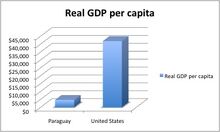Return to Table of Contents for Paraguay
Current Issues
Following the revolution, the War of the Triple Alliance came, with Paraguay fighting against Argentina, Brazil, and Uraguay, who had made a three-way alliance with each other. Paraguay was not ready and could not support a big war, but they soon had a 3,000 man army heading towards them. Luckily, this army lacked proper training, making there illusion of being a great army was false. By July of 1865, more than half of the 30,000 man army of Paraguay had been either killed or captured. In the end, the main leader of the war, Solano Lopez, was killed in battle. That year was marked Paraguay's lowest point in its history.
One of the most pressing issues in the present for Paraguay is the condition of their economy. Paraguays economy is primarily based around agriculture. It depends on exports such as soybeans, grains, cotton, and timber. While under Stroessner dictatorship, the economy was in fairly good shape due to the fact that they pursued mostly free market policies.

Infant Mortality Rate - Click to see larger
The government was centralized for the most part up until the 1992 constitution, which called for splitting up power. Under this new constitution, the first civilian president in forty years, was Juan Carlos Wasmosy. He had the support of the American government. In fact, the people of Paraguay declined an attempt by General Lino Oviedo, showing the unity of the people and their determination towards democracy. With the new Democratic government, the government has started to pursue foreign investment and privatizing industries that Stroessner kept under state control. Furthermore, the nation’s main cash crop, soybeans, saw reduced production. This was mainly due to a lack of rainfall in the region. Close to 35% of working Paraguayans are employed in agriculture. Also, inflation rose close to 10% in 2005, thanks in large part to a corrupt government, and world lows for soybean prices severally damaged the country’s income. The guarnanis, Paraguay’s equivalent of the dollar was at 3,000 guarnanís to 1 dollar in 1999. In 2006, it was up to 5,700 guarnanis for 1 dollar.

Life Expectancy and Population - Click to see larger
Another interesting issue now facing the country is that a president not part of the Colorado Party is in office. The Colorado Party had been in control of the government since the 1811 revolution. When elected on April 20, 2008, Fernando Lugo became the first freely elected leftist president in Paraguay history. He was a representative of "coalition of opposition parties." Two of his priorities were to decrease corruption and increase economic equality among the people. It has taken close to 200 years for this new development for several reasons. First, for many years, the country was ruled by a succession of dictators. Those men made sure that they would stay in the position of power as long as possible, mainly until their deaths. Secondly, it wasn’t until 1993 that there were truly “free” elections in the country. They had always given an unfair advantage to the Colorado Party before ’93. By then though, the people were so used to that party’s rule that it was an obvious vote for that party. However as things in the country have progressed it has become evident that was change was needed. Thus, in the last elections, Fernando Lugo created a new party altogether to fight against the Colorado Party. Throughout the elections, Lugo’s party, the Christian Democratic Party, started receiving defections from the Colorado Party. When the elections took place, Lugo was able to win by a 10% margin.

Literacy Rates - Click to see larger
How the Country is Shaped by the Revolution
Paraguay’s current status is deeply linked to its revolution. The social status and economic status are still similar to what they were right after the revolution. The government was similar as well until very recently, the last several months, where the Colorado Party was finally beaten in the presidential election. With society, one of the things that José Gaspar Rodríguez de Francia did was break down the powerful, taking it away from the weak and giving the power to the masses. We now see that with the current society and government.

Real GDP per Capita - Click to see larger
Paraguay is divided into 17 provinces and the capital city. Also, the society still revolves around the extended family. In fact, as many as three or four generations may live together in the same house or farm and this is considered typical. The economic structure has stay similar to what I once was but in recent years, it has started to pull away to the revolutionary style it once had. When José Gaspar Rodríguez de Francia became dictator in 1814, he isolated the country and took control of the economy. Under Alfredo Stroessner, a similar approach was taken and many industries were under state control. This in effect allowed for a strict set of laws in the economic system. However, under recent presidents, the many industries have now become privatized and the financial market has been deregulated causing inflation. See graphs above.

This chart shows the differences between the USA and Paraguay and their inflation rates. It is clear that the USA has a lower, more consistent inflation rate while Paraguay's is high and unpredictable.